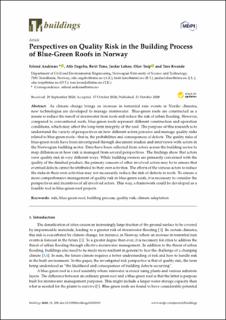| dc.contributor.author | Andenæs, Erlend | |
| dc.contributor.author | Engebø, Atle | |
| dc.contributor.author | Time, Berit | |
| dc.contributor.author | Lohne, Jardar | |
| dc.contributor.author | Torp, Olav | |
| dc.contributor.author | Kvande, Tore | |
| dc.date.accessioned | 2020-10-27T13:07:30Z | |
| dc.date.available | 2020-10-27T13:07:30Z | |
| dc.date.created | 2020-10-26T09:43:31Z | |
| dc.date.issued | 2020 | |
| dc.identifier.citation | Buildings. 2020, 10 (10), . | en_US |
| dc.identifier.issn | 2075-5309 | |
| dc.identifier.uri | https://hdl.handle.net/11250/2685290 | |
| dc.description.abstract | As climate change brings an increase in torrential rain events in Nordic climates, new technologies are developed to manage stormwater. Blue-green roofs are constructed as a means to reduce the runoff of stormwater from roofs and reduce the risk of urban flooding. However, compared to conventional roofs, blue-green roofs represent different construction and operation conditions, which may affect the long-term integrity of the roof. The purpose of this research is to understand the variety of perspectives on how different actors perceive and manage quality risks related to blue-green roofs—that is, the probabilities and consequences of defects. The quality risks of blue-green roofs have been investigated through document studies and interviews with actors in the Norwegian building sector. Data have been collected from actors across the building sector to map differences in how risk is managed from several perspectives. The findings show that actors view quality risk in very different ways. While building owners are primarily concerned with the quality of the finished product, the primary concern of other involved actors may be to ensure that eventual defects cannot be attributed to their own activities. The efforts of the various actors to reduce the risks in their own activities may not necessarily reduce the risk of defects in roofs. To ensure a more comprehensive management of quality risk in blue-green roofs, it is necessary to consider the perspectives and incentives of all involved actors. This way, a framework could be developed as a feasible tool in blue-green roof projects. | en_US |
| dc.language.iso | eng | en_US |
| dc.publisher | MDPI | |
| dc.rights | CC BY 4.0 | * |
| dc.rights.uri | https://creativecommons.org/licenses/by/4.0/ | * |
| dc.subject | Risk | en_US |
| dc.subject | Blue-green roof | en_US |
| dc.subject | Building process | en_US |
| dc.subject | Quality risk | en_US |
| dc.subject | Climate adaptation | en_US |
| dc.title | Perspectives on Quality Risk in the Building Process of Blue-Green Roofs in Norway | en_US |
| dc.type | Peer reviewed | en_US |
| dc.type | Journal article | en_US |
| dc.description.version | publishedVersion | en_US |
| dc.rights.holder | © 2020 The authors | en_US |
| dc.subject.nsi | VDP::Teknologi: 500 | en_US |
| dc.source.pagenumber | 18 | en_US |
| dc.source.volume | 10 | en_US |
| dc.source.journal | Buildings | en_US |
| dc.source.issue | 10 | en_US |
| dc.identifier.doi | 10.3390/buildings10100189 | |
| dc.identifier.cristin | 1842157 | |
| dc.relation.project | Norges forskningsråd: 237859 | en_US |
| cristin.ispublished | true | |
| cristin.fulltext | original | |
| cristin.qualitycode | 1 | |

